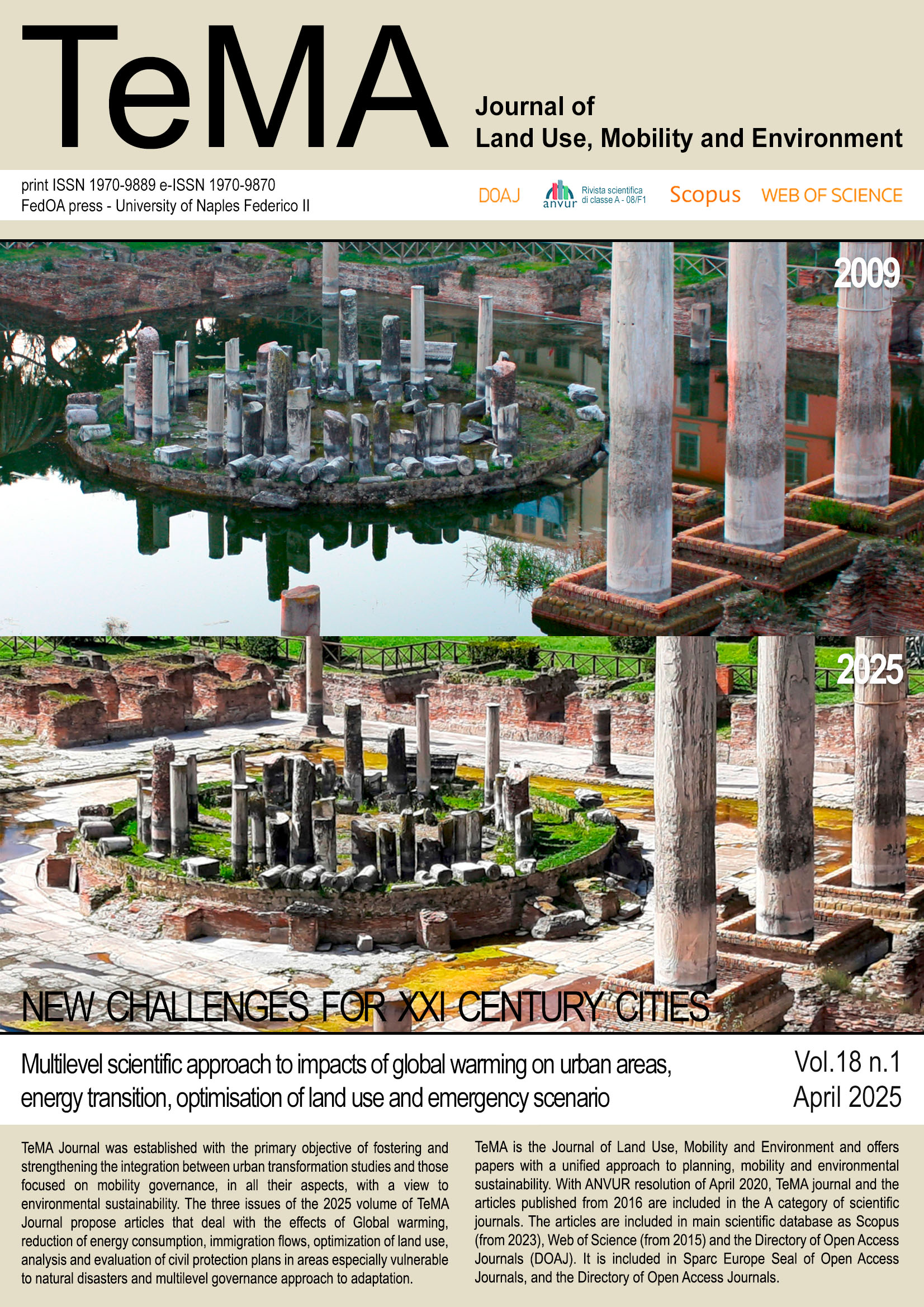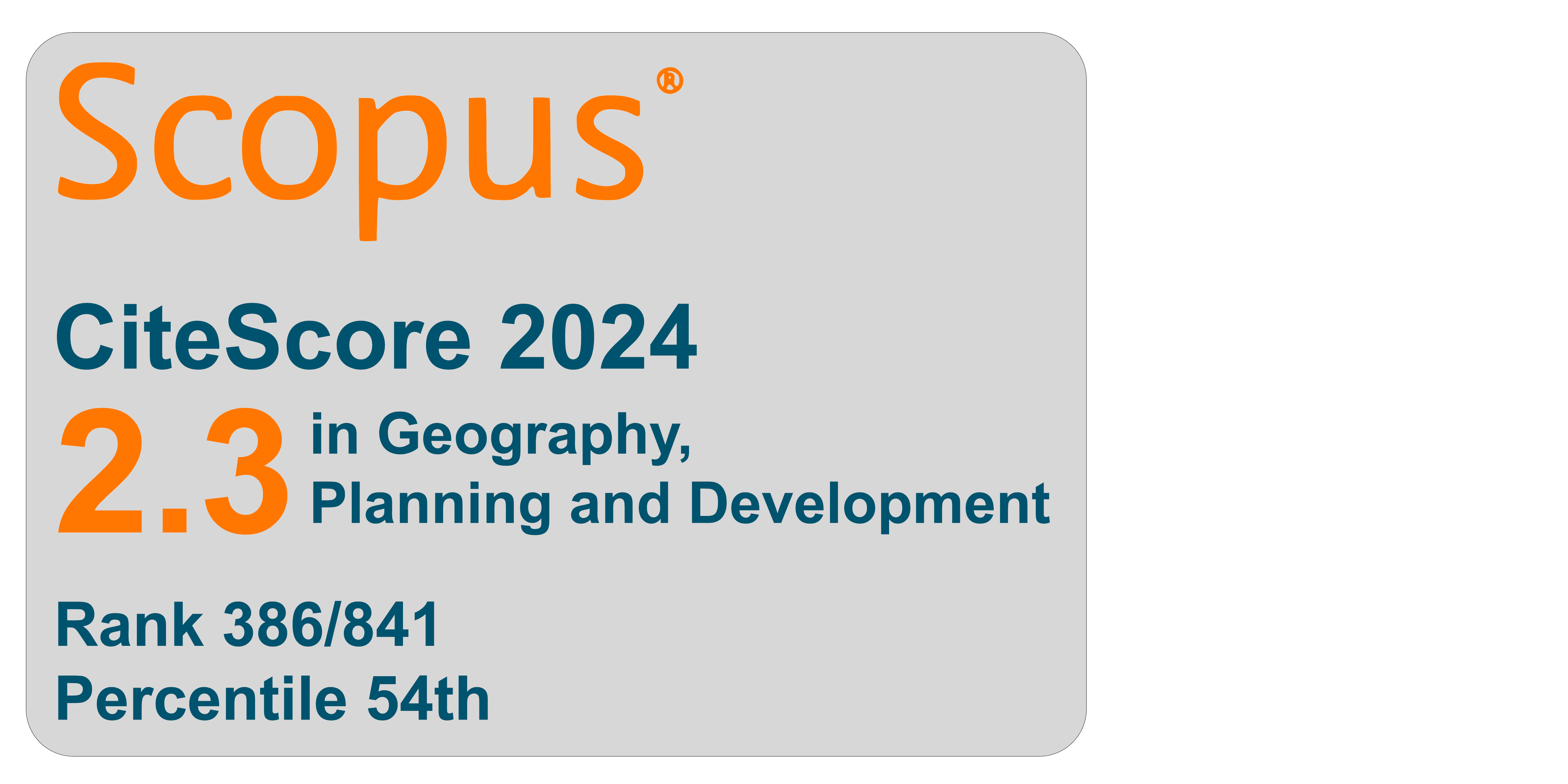Campi Flegrei and the Metropolitan Area of Naples. Emergency planning in a high-risk territory
DOI:
https://doi.org/10.6093/1970-9870/11228Keywords:
Campi Flegrei, Territorial planning, Emergency planningAbstract
The territory surrounding the city of Naples is characterized by three active volcanic risk sources: Vesuvius, Campi Flegrei, and the island of Ischia. The objective of this study is to examine the characteristics of emergency planning in response to volcanic risk. The methodology of the paper consists of three steps. The first step identifies the fundamental elements of this type of planning using international studies and national frameworks. The second step analyzes the emergency plan for Campi Flegrei, focusing particularly on its primary objective: the evacuation of the population in the event of a volcanic eruption. Additionally, this section examines the recent worsening of bradyseism in the Pozzuoli area, which, due to its location, has increased experts’ attention on the entire Campi Flegrei region. The third step involves a coherence analysis between the contents of the Campi Flegrei emergency plan and the guidelines outlined in the international studies and national frameworks introduced in the first step. The main results of the analysis highlight the strengths and weaknesses of the plan. Another significant finding confirms the close relationship between emergency planning and territorial planning. The current situation of the metropolitan area of Naples has been influenced by territorial plans that have paid insufficient attention to the risks present in the region. The next steps of the research emphasize the necessity for the new metropolitan plan to serve as an active tool for addressing territorial vulnerabilities. This should be approached with a focus on integrating risk mitigation into broader spatial planning initiatives.
Downloads
References
Alexander, D.E. (2003). Towards the Development of Standards in Emergency Management Training and Education. Disaster Prevention and Management, 12 (2), 113-123. https://doi.org/10.1108/09653560310474223
Alexander, E.R. (1997). Introduzione alla pianificazione. Teorie, concetti e problemi attuali. Napoli: CLEAN
Aspinall, W. & Blong, R. (2015). Chapter 70 - Volcanic Risk Assessment. In H. Sigurdsson (Ed.). The Encyclopedia of Volcanoes. Academic Press, 1215-1231. https://doi.org/10.1016/B978-0-12-385938-9.00070-5
Baxter P.J., Aspinall W.P., Neri A., Zuccaro G., Spence R.J.S., Cioni R. and Woo G. (2008). Emergency planning and mitigation at Vesuvius: A new evidence-based approach. Journal of Volcanology and Geothermal Research. 178 (3), 454-473. https://doi.org/10.1016/j.jvolgeores.2008.08.015
Bojanić Obad Šćitaroci, B., Pierantoni, I., Sargolini, M. & Sopina, A. (2021). Fostering holistic natural-risk resilience in spatial planning. TeMA - Journal of Land Use, Mobility and Environment, 155-179. https://doi.org/10.6093/1970-9870/7427
Bonadonna, C., Frischknecht, C., Menoni, S., Romerio, F., Gregg, C.H., Rosi, M., Biass, S., Asgary, A., Pistolesi, M., Guobadia, D., Gattuso, A., Ricciardi, A. & Cristiani C. (2021). Integrating hazard, exposure, vulnerability and resilience for risk and emergency management in a volcanic context: the ADVISE model. Journal of Applied Volcanology, 10 (7). https://doi.org/10.1186/s13617-021-00108-5
Brown, C.O., Hayes, J.L. & Milke, M. W. (2021). Planning to adapt: identifying key decision drivers in disaster response planning. Civil Engineering and Environmental Systems, 38 (1), 20-35. https://doi.org/10.1080/10286608.2021.1887155
Carlino, S. (2018). Volcanoes and Risk. In Carlino S. (Ed.), Neapolitan Volcanoes. A Trip Around Vesuvius, Campi Flegrei and Ischia. Cham: Springer
Carreño, M.L., Cardona, O.D. & Barbat, A.H. (2007). Urban Seismic Risk Evaluation: A Holistic Approach. Natural Hazards, 40, 137-172. https://doi.org/10.1007/s11069-006-0008-8
Cascetta, E. (2001). Transportation Systems Engineering: Theory and Methods. Dordrecht: Kluwer Academic Publishers
Cashman, K.V. & Giordano, G. (2008). Volcanoes and human history. Journal of Volcanology and Geothermal Research, 176(3), 325-329. https://doi.org/10.1016/j.jvolgeores.2008.01.036
Cheng, C.Y. & Qian, X. (2010). Evaluation of Emergency Planning for Water Pollution Incidents in Reservoir Based on Fuzzy Comprehensive Assessment. Procedia Environmental Sciences, 2, 566-570. https://doi.org/10.1016/j.proenv.2010.10.061
Chester, D.K., Degg, M., Duncan, A.M. & Guest, J.E. (2000). The increasing exposure of cities to the effects of volcanic eruptions: a global survey. Global Environmental Change Part B: Environmental Hazards, 2 (3), 89-103. https://doi.org/10.3763/ehaz.2000.0214
Città Metropolitana di Napoli (2008). PTC Napoli - Relazione, N01-0. Napoli: Città Metropolitana di Napoli.
Città Metropolitana di Napoli (2018). Linee di indirizzo per la predisposizione del Piano Strategico metropolitano triennale e identificazione delle Zone Omogenee. DCM 184, 27/11/2018
City of Chicago (2019). Resilient Chicago. A Plan for Inclusive Growth and a Connected City. Retrieved from: https://resilient.chicago.gov/download/Resilient%20Chicago.pdf
Di Lodovico L. & Di Ludovico D. (2018). Limit Condition for the Intermunicipal Emergency. TeMA - Journal of Land Use, Mobility and Environment, 11 (3), 305-322. https://doi.org/10.6092/1970-9870/5845
Di Ludovico D., Di Lodovico L. & Basi M. (2021). Spatial knowledge for risks prevention and mitigation. The civil protection planning of the Abruzzo Region. TeMA - Journal of Land Use, Mobility and Environment, 39-51. https://doi.org/10.6093/1970-9870/7404
Civil Protection Department (2019a). Campi Flegrei. Retrieved from: https://rischi.protezionecivile.gov.it/it/vulcanico/ vulcani-italia/campi-flegrei/
Civil Protection Department (2019b). Io non rischio. Retrieved from: http://iononrischio.protezionecivile.it/
De Lotto, R., Morelli di Popolo, C., Morettini, S. & Venco, E.M. (2013), La valutazione di scenari flessibili per la riduzione del rischio naturale. Planum, The Journal of Urbanism, 27
DPC (2021). Direttiva del Presidente del Consiglio dei Ministri del 30 aprile 2021, Indirizzi per la predisposizione dei piani di protezione civile ai diversi livelli territoriali
Emergency Management Australia (1998). Australian Emergency Manuals, Part 1: Planning Fundamentals. Canberra: Commonwealth of Australia
FEMA – Federal Emergency Management Agency (2020). Volcanoes. Retrieved from: https://www.ready.gov/volcanoes
Fox-Lent, C., Bates, M.E. & Linkov, I. (2015). A matrix approach to community resilience assessment: an illustrative case at Rockaway Peninsula. Environment System Decision, 35, 209-218. https://doi.org/10.1007/s10669-015-9555-4
Galderisi A., Guida G. & Limongi G. (2021). Emergency and spatial planning towards cooperative approaches. Challenges and opportunities in the multi-risk area of Campi Flegrei. TeMA - Journal of Land Use, Mobility and Environment, 73-92. https://doi.org/10.6093/1970-9870/7417
Gugg, G. (2018). Anthropology of the Vesuvius Emergency Plan: history, perspectives and limits of a dispositive for volcanic risk government. In L. Antronico, F. Marincioni (Eds). Natural Hazards and Disaster Risk Reduction Policies. 105-123. Rende, Il Sileno Edizioni
Heiken, G. (2013). Too many people and too many volcanoes - Naples, Italy. In: G. Heiken, Dangerous Neighbors. Volcanoes and Cities. Cambridge: Cambridge University Press
Hervás, J. (Ed.) (2003). Lessons Learned from Landslide Disasters in Europe. NEDIES Project, EUR 20558 EN. S.l.: European Communities
Hicks, A., Barclay, J., Simmons, P. & Loughlin, S. (2014). An interdisciplinary approach to volcanic risk reduction under conditions of uncertainty: a case study of Tristan da Cunha. Natural Hazards and Earth System Sciences, 14, 1871-1887. https://doi.org/10.5194/nhess-14-1871-2014
Iervolino, I., Cito, P., De Falco, M., Festa, G., Herrmann, M., Lomax, A., Marzocchi, W., Santo, A., Strumia, C., Massaro, L., Scala, A., Scotto di Uccio, F. & Zollo, A. (2024). Seismic risk mitigation at Campi Flegrei in volcanic unrest. Nature communications, 15:10474. https://doi.org/10.1038/s41467-024-55023-1
INGV (2024). Vesuvio. Storia eruttiva. Retrieved from: https://www.ov.ingv.it/index.php/monitoraggio-sismico-e-vulcanico/vesuvio/vesuvio-storia-eruttiva. 5/9/2024
Lindell, M.K. & Perry, R.W. (1992). Behavioral Foundations of Community Emergency Planning. Washington: Hemisphere Publishing
Mazzeo, G. (2009). Naples. Cities, 26 (6), 363-376. https://doi.org/10.1016/j.cities.2009.06.001
Mela, A., Mugnano S. & Olori, D. (2017). Territori vulnerabili: Verso una nuova sociologia dei disastri italiana. Milano: FrancoAngeli
Menoni, S. & Pesaro, G. (2008). Is relocation a good answer to prevent risk? Criteria to help decision makers choose candidates for relocation in areas exposed to high hydrogeological hazards. Disaster Prevention and Management, 17, 33-53. https://doi.org/10.1108/09653560810855865
Mileti, D.S. & Passerini, E. (1996). A social explanation of urban relocation after earthquakes. International Journal of Mass Emergencies and Disasters, 14 (1), 97-110
New Zealand Government (2002). Civil Defence Emergency Management. Wellington: Government of New Zealand
Norton, J., Atun, F. & Dandoulaki, M. (2015). Exploring Issues Limiting the Use of Knowledge in Disaster Risk Reduction. TeMA - Journal of Land Use, Mobility and Environment, 135-154. https://doi.org/10.6092/1970-9870/3032
Núñez, A.G., Penadés, M.A., Canós, J.H. & Borges M.R.S. (2015). Towards a Total Quality Framework for the Evaluation and Improvement of Emergency Plans Management. Short Paper. Planning, Foresight and Risk Analysis Proceedings of the ISCRAM 2015 Conference. Kristiansand, May 24-27, 2015
Papa, R. & Mazzeo, G. (2014). Characteristics of sprawl in the Naples Metropolitan Area. Indications for Controlling and Monitoring Urban Transformations. Computational Science and Its Applications - ICCSA 2014. 14th International Conference. Guimarães, Portugal, June 30 - July 3, 2014, Proceedings, Part II. Lecture Notes in Computer Science, 8580: 520-531. https://doi.org/10.1007/978-3-319-09129-7_38
Pareschi, M.T., Cavarra, L., Favalli, M., Giannini, F. & Meriggi, A. (2000). GIS and Volcanic Risk Management. In G.A. Papadopoulos, T. Murty, S. Venkatesh, R. Blong (Eds). Natural Hazards. Springer, Dordrecht. https://doi.org/10.1007/978-94-017-2386-2_16
Perry, W. & Lindell, M. (2003). Preparedness for emergency response: guidelines for the emergency planning process. Disasters, 27 (4), 336-350. https://doi.org/10.1111/j.0361-3666.2003.00237.x
Quarantelli, E.L. (1982). Ten Research-derived Principles of Disaster Planning. Disaster Management, 2, 23-25
Quarantelli, E.L. (1985). Emergent Citizens Groups in Disaster Preparedness and Recovery Activities. Newark: University of Delaware Disaster Research Center
Ricci, T., Nave, R. & Barberi, F. (2013). Vesuvio civil protection exercise MESIMEX: survey on volcanic risk perception. Annals of Geophysics, 56 (4): S0452-6. https://doi.org/10.4401/ag-6458
Rockett, J.D. (1994). A Constructive Critique of United Kingdom Emergency Planning. Disaster Prevention and Management, 3 (1): 47-60. https://doi.org/10.1108/09653569410049667
Rolandi, G. (2010). Volcanic hazard at Vesuvius: An analysis for the revision of the current emergency plan. Journal of Volcanology and Geothermal Research, 189 (3-4). 347-362. https://doi.org/10.1016/j.jvolgeores.2009.08.007
Tira M. (2021). Planning to prevent disasters. TeMA - Journal of Land Use, Mobility and Environment, 191-202. https://doi.org/10.6093/1970-9870/7890
Tomasone M., Avvisati G., Cirillo F., Colucci O., Marotta E., Fiorenza E., Vertechi E. & Simonetti B. (2022). Risk management planning on a volcanic island: fear and loathing in Ischia (Italy). Geological Society, London, Special Publications, 519, 147-165. https://doi.org/10.1144/SP519-2021-183
Troise, C., De Natale, G., Somma, R., Buscema, M., Maurelli, G. Giannola, A., Petrazzuoli, S. (2022). Mitigating the highest volcanic risk in the World: a multidisciplinary strategy for the Neapolitan area. EGU22, the 24th EGU General Assembly, 23-27 May, Wien.
UN (1985). Volcanic Emergency Management. Office of the United Nations Disaster Relief Coordinator (UNDRO), United Nations Educational Scientific and Cultural Organization (UNESCO). New York: United Nations. Retrieved at: https://unesdoc.unesco.org/ark:/48223/pf0000080351
Wei H.L. (2021). Natural Hazards: Volcanic Eruptions. In L.R. Shapiro, M.-H. Maras (Eds.), Encyclopedia of Security and Emergency Management. 697-700. Springer Nature Switzerland AG 2021. https://doi.org/10.1007/978-3-319-70488-3
Downloads
Published
How to Cite
Issue
Section
License
Copyright (c) 2025 TeMA - Journal of Land Use, Mobility and Environment

This work is licensed under a Creative Commons Attribution-NonCommercial 4.0 International License.



